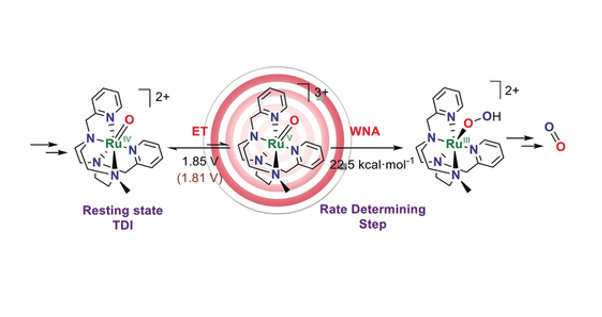A new family of ruthenium complexes based on the N-pentadentate ligand Py2Metacn (N-methyl-N′,N′′-bis(2-picolyl)-1,4,7-triazacyclononane) has been synthesised and its catalytic activity has been studied in the water-oxidation (WO) reaction. We have used chemical oxidants (ceric ammonium nitrate and NaIO4) to generate the WO intermediates [RuII(OH2)(Py2Metacn)]2+, [RuIII(OH2)(Py2Metacn)]3+, [RuIII(OH)(Py2Metacn)]2+ and [RuIV(O)(Py2Metacn)]2+, which have been characterised spectroscopically. Their relative redox and pH stability in water has been studied by using UV/Vis and NMR spectroscopies, HRMS and spectroelectrochemistry. [RuIV(O)(Py2Metacn)]2+has a long half-life (>48 h) in water. The catalytic cycle of WO has been elucidated by using kinetic, spectroscopic, 18O-labelling and theoretical studies, and the conclusion is that the rate-determining step is a single-site water nucleophilic attack on a metal-oxo species. Moreover, [RuIV(O)(Py2Metacn)]2+ is proposed to be the resting state under catalytic conditions. By monitoring CeIV consumption, we found that the O2 evolution rate is redox-controlled and independent of the initial concentration of CeIV. Based on these facts, we propose herein that [RuIV(O)(Py2Metacn)]2+ is oxidised to [RuV(O)(Py2Metacn)]2+ prior to attack by a water molecule to give [RuIII(OOH)(Py2Metacn)]2+. Finally, it is shown that the difference in WO reactivity between the homologous iron and ruthenium [M(OH2)(Py2Metacn)]2+ (M=Ru, Fe) complexes is due to the difference in the redox stability of the key MV(O) intermediate. These results contribute to a better understanding of the WO mechanism and the differences between iron and ruthenium complexes in WO reactions.
